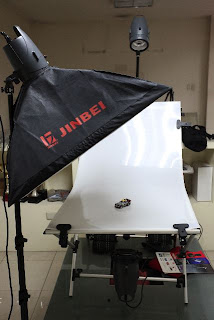The Main:
First of is obviously the camera. I have tried both Canon and Nikon and to be honest both are the same. It's a matter of brand preference. However there are certain things that I like with Canon that cannot be found on Nikon and vice-versa. I will not mention other brands because I did not have the privilege of owning them.
I use a Canon 5D Mark II and an IR converted Canon 30D (courtesy of my good friend Jimmy).
IR Converted 30D
The Bodies:
For the IR camera I use a Canon 17-40mm f4 L lens (pictured above) which is good for landscape shots. Because of the nature of the lens you can shoot your subject up close and get 'comical' pictures.
For most of the pictures that you see on this blog they were taken with a Canon 100mm f2.8 macro lens (pictured below).
Sometimes I tend to move far away from the subjects when they are big (space restriction on my room) so I use a Canon 70-300mm f3.5-5.6 lens instead (pictured below).
The Lights:
I am fortunate enough to have a good friend (Jimmy once again) who lets me use his strobes for my toy shots. Since he owns 2 big strobes he lets me play with these small ones to which I have to say are perfect for table top PhoTOYgraphy.
First we have a 180 watts Jinbei strobe that is being sold as a set with stands, an umbrella, a softbox and a grid. You can purchase this as a basic starter lighting kit locally at Aperture Trading for about P 16,500.00. In my experience Jinbei is more durable than what I previously used and I would highly recommend this.
The Accessories:
One of the most useful accessories for me is a grid. It basically narrows the light and creates a circle like effect on the subject. This grid is attached on the top of one of the Jinbei lights.
All these things are useful but to fire them remotely you will need a trigger of some sort. There is an IR trigger which is inexpensive and easy to use and remote triggers which are expensive and sophisticated.
One such IR trigger that I use is a brand called Morris (I took of the sticker and replaced it with my own) which works flawlessly most of the time. An IR trigger is usually bundled with the Jinbei set.
If you do not mind spending extra then the more sophisticated remote trigger is a lot better. Sometimes I use my Pocket Wizard Flex TT5 and Mini TT1 (almost P 20,000.00 for the set) instead of the IR trigger. Usually the Morris IR trigger works with my studio setup so I keep my Pocket Wizards in the bag. Sometimes I prefer to use them when I need a more complexed setup.
One last thing that I always have is a flash light or pen light. This is a useful tool for light painting (to which I credit Mr. Jo Avila for teaching me this technique). Some pictures of Phoenix, Dark Phoenix and Kotobukiya Batman were shot using a flash light. Jo prefers a push button flash light so you can turn it on and off quickly and I completely agree with this.
You can also put colored gels or transparent papers in front of the flash light to create colored lights.
I bought a product table (Falcon Eyes, P 4,400.00) for table top photography and PhoTOYgraphy. The table collapses for storage and has a transparent like bendable platform that you can adjust.This bendable platform makes for a seamless background and also light can pass through it.
Finally, this is what my setup looks like. You can see the softbox on the right side of the product table and all 3 lights are being used.
Using the setups pictured above this is what you get:
You can position the lights differently and get interesting results. All it takes is a bit of research and a great deal of patience.
Hope this helps!













Very informative post.
ReplyDeletethanks for taking the time to check it out =D
ReplyDeleteThanks for sharing your equipments, they are wonderful! And I know how to use them is another story to tell... =)
ReplyDeleteHey Luke, thanks for checking it out =D
ReplyDelete